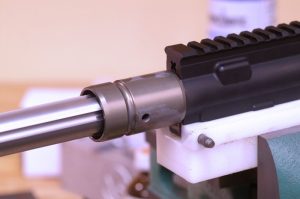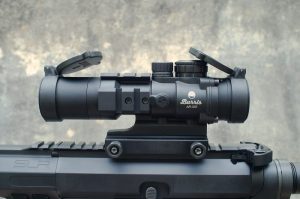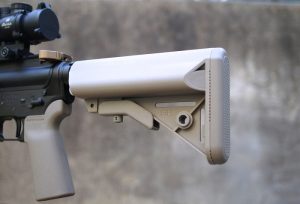We’re all on a budget! However, spending money wisely determines the value you’ll get from an AR-15 project. There is a huge array of AR-15 components available. Shopping options usually involve two criteria. First, is the part suitable for what I envision for the completed gun? Second, is the part at the lowest price I can get?
A better rail will fit and feel great, be sturdy, and, as a big bonus, can be more straightforward to install. The barrel nut and handguard attachment on this Geissele Automatics system totally bypass gas tube alignment slots. Much easier!
That second drives many of us! No one wants to spend more than they have to, and for many, investing less is not only a main motivation in DIY building, but can become the focus—get a functional gun together for a song. Well. That’s not always wise. There are a few components where the “next” level can pay off—not only in the long run but also in the initial satisfaction with your new gun.
Over many years of building AR-15s, I’ve had experience with all levels or tiers of components. And, yes, virtually each of the nearly 100 parts that can make up an AR-15 exist available as good, better, best.
“Best” is the easiest! It’s usually pretty clear which represent the component examples that fit at the top tier of options. They cost the most, and are largely known to work well. It’s determining the line between “good” and “better” that’s the trick. That is about value. “Value,” to me, is a combination of price and performance, and performance mostly. Judging performance is very much subjective: what do you expect, what are you happy with?
Which AR-15 parts matter the most?

A better rail will fit and feel great, be sturdy, and, as a big bonus, can be more straightforward to install. The barrel nut and handguard attachment on this Geissele Automatics system totally bypass gas tube alignment slots. Much easier!
The barrel is the short answer. A better barrel shoots smaller groups. From my perspective as a competitive shooter, a “good” barrel costs about as much, maybe more, than an entire AR-15 parts kit, including a barrel. I can’t tell everyone they need a Krieger, but I can tell everyone they will likely be more impressed if they ante up another $100 for a barrel. That means going from $150 to $250. Brand still matters, and we’re trusting that the extra money charged for the barrel has its origin in machining and finishing quality (which, depending on brand, may or may not have been the case).
Another is the forend rail, or handguard. Two main reasons. One is that a “better” rail is, or can be, more straightforward to install. Any system that gets away from that GI-style scalloped barrel nut where one of the scallops has to be perfectly centered to allow contact-free gas tube passage is an improvement. Then just take it to torque and move on. Another reason is that a better rail is usually has a more sturdy attachment system. I much prefer anything that has a “cross-bolt” style to lock the rail to the barrel nut apparatus as opposed to simple set screws around the perimeter of the barrel nut. Check the screws! Especially after a few trips to the range, and light-duty threadlocker is wise (“blue”).
In my experience, the extra cost in a handguard rail is usually in its attachment, and that, ultimately, is where a lesser rail might let you down. That is the “strength” in a rail. There’s not usually a whopping lot of functional difference in the tubes themselves, aside from a more expensive rail might have had sharp edges broken and, overall, cleaner machining, and also a nicer finish.

Don’t get a cheap sight. This is not a cheap sight, but it’s affordable. A cheap sight will, not can, let you down.
The Buttstock
Another system assembly is the buttstock, and I’m referring to a collapsible-style stock. Better stocks are less likely to rattle, stutter, and stick. Unlike barrels and rails, it doesn’t cost much more to get a much better stock.
Of all the system components on any rifle or carbine, it’s the sight that probably has the widest price range. It’s also another part where spending up a little, not necessarily a lot, can make a big difference in performance. It’s easy for me to write an entire article on what makes a bad sight bad, but it’s mostly that it won’t hold zero. Adjustments aren’t accurate: put on three clicks, for instance, and then take one off and it either doesn’t move or jumps two. Competitive shooters call those “dead clicks” and even if we’re not shooting at small targets for a score, it’s important that a sight doesn’t decide to just move itself to another point on the target.
When I say “sight” I mean “optic.” I really never liked the term “common sense” because it often comes across as demeaning to those we might be insinuating don’t have it. However! Folks, if you’re looking at a zoot-capri do-it-all optical sight and it’s less than $200 dollars, it’s liable to be just terrible. It takes more than “features” to make a good sight. Features largely are in circuitry and easily duplicated, but what matters is still (and always) mechanical. If you’re on a budget, shop common brands; don’t buy one you haven’t heard of.
Which parts don’t “really matter”? Now. Don’t read too much into that. All parts matter, and all have to be up to the job. However, there are a few components that spending up for will not make or break your gun. Receivers are at the top of that list. As long as the receiver is true USGI mil-standard, and preferably produced by a contractor, that part is just fine. Sure, I like billet-made because of (primarily) aesthetics, but I honestly cannot tell you that I’ve ever been able to prove functional superiority on target, and I’ve also not been able to prove functional superiority.

A high-quality stock makes a noticeable, daily improvement in the fit and feel of your AR-15. This is a B5, my favorite.
Same goes for bolt carrier groups. It has to (has to) be true USGI mil-standard, and that means it’s produced to blueprint specifications. And that means also that the parts are not only dimensionally correct but made from the correct materials and have been treated. For instance: Carpenter 158 bolt, or 9310, heat treated; chrome lined bolt recess; carrier body of 8620 steel. Again, I like the “premium” carriers, but honestly cannot tell you I’ve seen better shot groups. Mostly, a plated or coated carrier will indeed run smoother and, mostly, cleans up easier.
One last AR-15 component for a better build: Magazines.
Get good ones. Good ones don’t cost much more, but they won’t be as likely to let you down at a crucial moment.
What are you favorite AR-15 upgrades for a build? Share your answers in the comment section.
Cocked and Locked is the official content provider of TheBestShootingSite.com. Be sure to also check out: Is the Ammunition Shortage Real or Manufactured?

